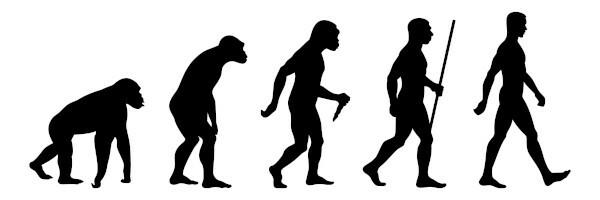Phylogeny can be defined, in a simplified way, as the evolutionary history of a species or from a set of distinct species. We can compare the study of phylogeny with the study of a tree genealogical. By studying phylogeny, we can know the ancestors of a species and understand how certain characteristics emerged in those organisms.
For a long time, it was believed that primitive living beings were inferior organisms, and that they underwent modifications until they became more advanced organisms, an idea that leads to the belief that the evolution it takes place in a ladder scheme, with the higher bodies at the top. We now know, however, that evolution is best represented by a tree, with many branches.
Read more: Biology andevolutionary - aims to unravel how species change over time
phylogenetic tree
Phylogenetic trees are nothing more than the representation of the evolutionary history of a species. These representations must be read from base to tip., the base being the oldest history and the tips the most recent history of that taxon.
Phylogenetic trees are often formed by a series of dichotomies or branch points two-way, in which lineages diverge, that is, where speciation occurs. If we look at the following figure, we will see that, at each branch point, an ancestral lineage gives rise to, generally, two daughter lineages. Each of these lineages presents its own evolutionary history, being a part of that history shared with other lineages.

When we observe that from a branch point more than two groups of descendants arise, we have a polytomy (see branch point 5). The presence of a polytomy generally indicates that the evolutionary relationships observed between groups of living beings are not yet well defined. Deepening the study of these groups can resolve this polytomy. Another explanation for polytomies is the occurrence of rapid speciations that occurred at the same time, giving rise to different lineages.
Do not stop now... There's more after the advertising ;)
In a phylogenetic tree, when we observe two organisms that share an immediate common ancestor, we call them sibling taxa (example: taxon B and C). This means that these organisms are very close to each other. The term basal taxon is used to refer to a lineage that originated close to the common ancestor of the group, diverging early in the evolutionary history of the studied group (example: taxon G).
It is important to highlight that when we talk about phylogenetic trees, we are not referring to the similarities phenotypic, that is, the closest organisms are not necessarily the most morphologically similar.
Another important point to be highlighted is the fact that the length of the branches is not related to time.. Therefore, when interpreting a phylogenetic tree, unless time information is included, our focus should be offspring and not the dates when these events occurred.
Finally, we can never say that a living being evolved from a species close to it, we can only say that they have a common ancestor. In addition to all the points already highlighted, it is important to emphasize that phylogenetic trees they should not be interpreted to consider that some taxa are more advanced than others.
Read more: Speciation - refers to the division of a lineage that produces two or more different species.
Phylogeny of the human species
Until today, there is still a lot of confusion when it comes to the evolution of the human species. It is very common to hear that the ifhuman res evolved from chimpanzees. However, when we look at the evolutionary history of these species, we realize that they, in fact, share a common ancestor, therefore showing a close relationship. This ancestor, however, is neither a human nor a chimpanzee, as many people think.

Another important point concerns the way in which the evolutionary history of the species is represented. Although the previous figure is very widespread, it is completely incorrect. This is due to the fact that the design conveys a conception that human evolution occurred based on change from inferior beings to the emergence of more advanced beings, which would be human beings modern. The image conveys an idea of the superiority of our species, an idea of progress, which should not be disseminated.
By Vanessa Sardinha dos Santos
Biology teacher


